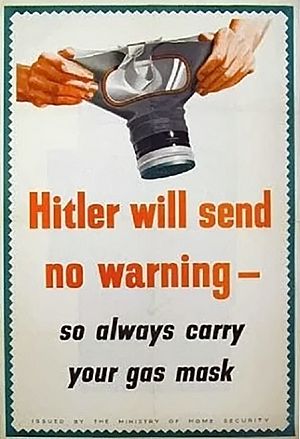Ministry of Home Security facts for kids
The Ministry of Home Security was a special British government department created in 1939. Its main job was to organize how people would stay safe during the Second World War, especially from air raids. This was called "civil defence."
The Ministry was led by Sir John Anderson, who was also the Home Secretary (a very important government official). It was in charge of many groups, like air raid wardens, rescue teams, fire services, and the Women’s Voluntary Service. It also made sure that local areas had plans for air raids and built public shelters for people to hide in.
Working with the Home Office, the Ministry sent out many leaflets to families. These leaflets gave advice on what to do during air raids. They also made posters to encourage people to carry gas masks and to join civil defence groups, like the Fire Guards.
In October 1940, Herbert Morrison took over from Sir John Anderson. This happened after Neville Chamberlain resigned because he was unwell.
When the Allies won the war in Europe in May 1945, the Ministry of Home Security was no longer needed and was closed down.
Contents
Why the Ministry Was Needed
During the First World War, not much was done to protect ordinary people from attacks. But before 1939, leaders realized that things had to change. They knew that if another war started, cities would likely be bombed. So, plans for the new Ministry were ready even before the Second World War officially began.
How the Ministry Worked
The Ministry of Home Security was created by a special law in 1939. This law gave the new Minister of Home Security the powers that used to belong to other government officials, like the Home Secretary.
Sir John Anderson, who had been the Lord Privy Seal (another government role), became the first Minister of Home Security. His new department combined parts of the Home Office that dealt with air raid precautions (ARP). Many new staff members joined from other government offices and local councils. The Ministry also took over control of how factories and businesses prepared for air raids.
The Ministry had two main jobs during the war:
- First, it brought together all the different civil defence services that other government departments were running.
- Second, it managed its own services and helped local councils with their civil defence plans. This included:
* Approving all air raid precaution plans. * Building and providing air raid shelters. * Sounding air raid warnings (starting in 1943). * Supplying equipment for air raid precautions. * Coordinating and watching over the regional civil defence groups. These groups included the Civil Defence Rescue Service, Air Raid Warden Service, Fire Guard Service, Shelter Service, Women's Voluntary Service, and the Civil Defence Reserve.
The Ministry divided Britain into 12 civil defence regions. Each region had a special commissioner who helped organize all the local services. In London, there was a central "Home Security War Room." This room collected information from the 12 regional war rooms about air raids, injuries, and where civil defence workers might need to be moved.
When it first started, the Ministry had five main sections:
- Air Raid Precautions Department
- Fire and Police Services Division
- Regional Organisation Division and Home Security War Room
- Inspector General's Department
- Public Relations and Civil Defence Personnel Division
End of the Ministry
After the victory in Europe in May 1945, the Ministry was closed. Any remaining tasks or departments went back under the control of the Home Office.
What the Ministry Was Responsible For
Twelve commissioners were appointed to manage the 12 regions of the UK. They were responsible for many things, such as:
- Providing air raid shelters.
- Organizing air raid wardens.
- Having gas identification officers.
- Making sure ambulances were available.
- Leading rescue operations after bombings.
Millions of gas masks were given out to people. Almost five million people signed up to be fire watchers and firefighters. The Ministry also had to prepare for a possible invasion of Britain. This included making plans for what to do if the country's communication systems were destroyed by enemy attacks.
From 1939, there were 12 regional "War Rooms" and one national "War Room." After 1941, the Ministry's main war room was in London.
Leaders of Home Security
- 1939-1940: Right Hon. Sir John Anderson MP
- 1940-1945: Right Hon. Herbert Stanley Morrison MP
Important People in the Ministry
- John Baker, Baron Baker - a science advisor from 1939 to 1943.
- Moses Blackman - a science advisor from 1942 to 1945.
- Peter Floud - a main leader at the London Regional Headquarters from 1939 to 1944.


